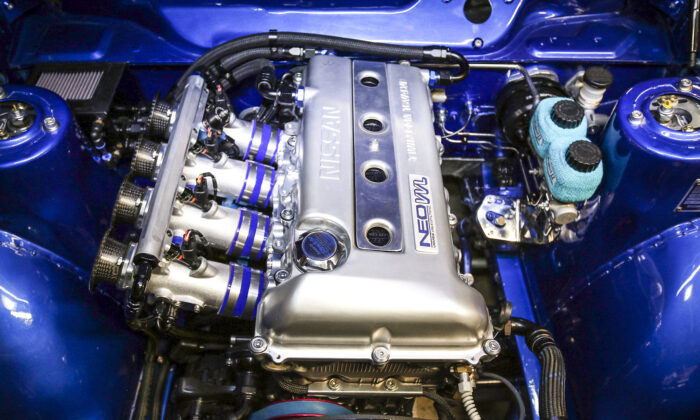The 2.0-liter Nissan SR20DE engine was produced at the company’s plants from 1989 to 2002 and was used in many popular models of the concern, such as Almera, Primera or Sylvia. The same powertrain, but in a mono-injection version, was assembled under a different index SR20Di.
The SR family also included SR16VE, SR18DE, SR20DET, SR20VE and SR20VET engines.
Engine specifications for Nissan SR20DE 2.0 l
| Configuration | Inline |
| Number of cylinders | 4 |
| Number of valves | 16 |
| Displacement | 1998 cc |
| Cylinder diameter | 86 mm |
| Stroke | 86 mm |
| Power system | Distributor Injection System |
| Engine power | 130 – 165 hp |
| Torque | 170 – 195 Nm |
| Compression ratio | 9.5 – 10 |
| Fuel type | Regular |
| Euro class | EURO 2/3 |
SR20DE engine dry weight is 160 kg
Description of the SR20DE 2.0L Engine
The Nissan SR family of engines was ahead of its time in October 1989 – the 2.0-litre variant featured distributed fuel injection, an aluminium cylinder block, 16-valves with hydro-compensators and a chain timing system. It was thoroughly engineered to ensure optimal performance and could generate up to 165 hp depending on the modifications made. An essential identifying point for this engine is the SR20DE engine number located at the junction of the engine and gearbox. Thanks to these advanced features, owners of vehicles featuring this revolutionary motor benefit from reliable power and unbeatable performance for many years after its initial release.

The first versions of the unit were designed with sports cars in mind and featured distinctive bright-colored valve covers, earning them the “Red or Blue Top” moniker in catalogs. In 1994, production of standard editions started, though they were heavy on emissions, with a small camshaft lift and subdued black and silver valve covers. Fast forward to 2000, where a new modification of the model was released with a lightweight crosshead and roller rockers incorporated for greater efficiency. This iteration marked an important transition for the unit and cemented its place as an industry leader in its setup.
Fuel consumption SR20DE
Nissan Primera P11 with a manual transmission as an example (l/100km):
| City | 11.4 l |
| Highway | 6.2 l |
| Combined | 8.1 l |
What cars have the Nissan SR20DE
| 180SX 4 (S13) | 1991 – 1998 |
| 200SX 5 (S14) | 1995 – 1998 |
| Almera 1 (N15) | 1995 – 2000 |
| Almera Tino 1 (V10) | 1998 – 2006 |
| Avenir 1 (W10) | 1990 – 2001 |
| Bluebird 8 (U12) | 1989 – 1992 |
| Bluebird 9 (U13) | 1991 – 1997 |
| Bluebird 10 (U14) | 1996 – 2001 |
| Presea 1 (R10) | 1990 – 1995 |
| Presea 2 (R11) | 1995 – 2000 |
| Primera 1 (P10) | 1990 – 1996 |
| Primera 2 (P11) | 1995 – 2002 |
| Pulsar 4 (N14) | 1990 – 1995 |
| Pulsar 5 (N15) | 1995 – 2000 |
| Sentra 3 (B13) | 1990 – 1994 |
| Sentra 4 (B14) | 1995 – 1999 |
| Silvia 5 (S13) | 1991 – 1994 |
| Silvia 6 (S14) | 1993 – 2000 |
| Serena 1 (C23) | 1991 – 2000 |
| Wingroad 1 (Y10) | 1996 – 1998 |
| G20 P10 | 1990 – 1996 |
| G20 P11 | 1998 – 2002 |
Reviews on the engine CP20DE
Advantages:
- Simple and reliable motor design
- Common and inexpensive spare parts
- Timing chain drive with a long service life
- The hydro-compensators in the cylinder-head are included
Disadvantages:
- Difficult to find an engine in good condition
- Quite picky about the quality of lubrication
- Clogging of ECG and EGR system on a regular basis
- Frequent failure of detonation sensor
SR20DE 2.0 l engine maintenance
| Interval | Every 15 000 km |
| Oil capacity | 4.0 l |
| Need to change | 3.4 l |
| Type of oil | 5W-30, 5W-40 |
| Timing Chain Type | Chain |
| Service life | not limited |
| In practice | 300 000 km |
| At breakage/trans-skip | Bending of valves |
| Re-adjustment | not required |
| Adjustment principle | hydrocompensators |
| Oil filter | 15 000 km |
| Air filter | 30 000 km |
| Fuel filter | 60 000 km |
| Spark plugs | 30 000 km |
| Drive belt | 90 000 km |
| Coolant | 3 years or 45 000 km |
Problems & disadvantages of the SR20DE
Floating RPMs
This power unit has gained a reputation for being fairly reliable and is noted for not having apparent weaknesses. Appreciated by professionals worldwide, on forums the most common complaints are usually related to issues with contamination of the idle valve resulting in floating revolutions. This is frequently due to a fault with either the DMV or lambda probe that needs replacing if instability persists. As such, these components should be included in scheduled checkups and maintenance runs to ensure maximum output performance from this dependable unit.
Ignition system
Engine durability is a must for a reliable series, and the inclusion of an ignition system with a flame arrestor is key to this. The long life expectancy of parts such as the shaft seal usually comes with ease of replacement – grease may start to leak, but this part can be changed easily and quickly. For users that wish to go beyond maintenance, they may also change the high-voltage wires for improved performance; it is recommended that these be sourced from the original supplier to ensure cohesiveness with the other engine components.
The EGR valve
An EGR valve is a vital component of most engines, yet when it gets clogged up due to dirt and debris build-up, it can have catastrophic effects on the engine’s performance. Owners may instinctively try to muffle such problems, but this usually results in increased fuel consumption which is both costly and environmentally unfriendly. Fortunately, a simple maintenance check involving a thorough cleaning will usually suffice to restore the EGR valve’s normal functioning; however, if regular maintenance practices are not adhered to, the problem could persist and require the expertise of a qualified mechanic.
The manufacturer says the SR20DE engine life is 200,000 km, but it can go up to 400,000 km.
 Infiniti
Infiniti
0 Comments